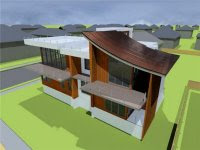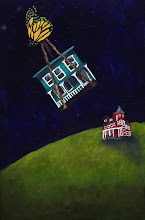

When James was working on his thesis for his MFA, he combined painting and sculpture with a series of works called "The Inhabitables." Working on a scale which would mimic the relationship of mother and infant (the paintings were huge and the viewers were the infants) he placed protruding orifices in strategic spots. The result was simultaneously comforting and disconcerting. Years later we attended an exhibition at the New Museum called Cloaca, a mechanical digestive system by Dutch artist Wim Delvoye which was fed twice a day and eliminated at 2:30 pm to much glee from the expectant crowd. This biotechnical sculpture fueled itself, creating its own energy from the corn it digested.
Most recently, the Park Avenue Armory in NYC is hosting the Ernesto Neto exhibition, seen above. With his womblike structures dripping with sacks of spices, the space combines art, architecture, and body in a multisensory installation. The show, which closes on June 14th, is one that is worth rearranging your weekend to see.
Clearly, the body as artistic inspiration is nothing new; however it has never seemed more pertinent as our society moves forward in terms of stem cells and cloning. Some of the advances come from seemingly surprising places. One such place is the International Science and Engineering Fair. Seventeen year old winner Pragya Kakani's project A Microarray Based RNA in situ Hybridization Screen for Novel Cell Adhesion Genes in Cerebellar Basket and Stellate Interneurons almost lost me at the title, but upon hearing how she analyzed brain function, I became curious to see how her research could inspire art and architecture. The cerebellum and its interneurons play a key role in integrating of sensory perception and motor coordination; however, currently little is known about the mechanisms guiding synapse formation. The goal of her study was to identify genes that may be responsible for synapse formation by coding cell adhesion molecules (CAMs), or proteins that facilitate cell to cell interactions. Her research isolated approximately nine genes which are strong candidates for future investigation. One can only begin to imagine the possibilities if this type of scientific research on sensory perception and motor coordination could make its way into modern medicine as well as art and architecture.





1 comment:
I'm very interested in the synergy between art and science so these are great resources, thanks!
I've tagged you on my blog to share with the internets six uninteresting things that make you happy (but only if it makes you happy to do it!)
Post a Comment